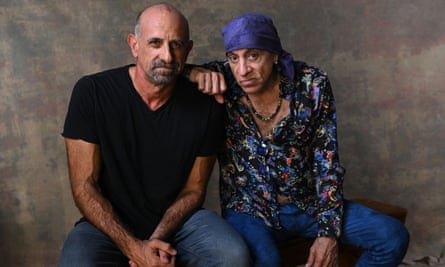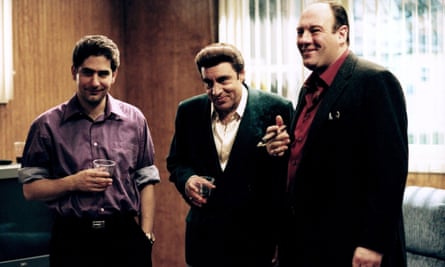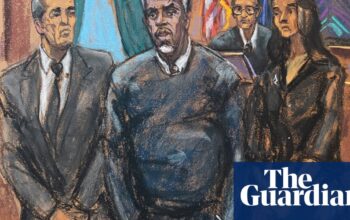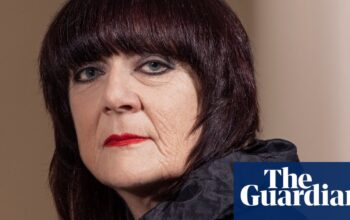For Stevie Van Zandt, unique as the consigliere to both Bruce Springsteen and Tony Soprano, the moment of political awakening came four decades ago in white minority rule South Africa.
“I was in a cab and a Black guy stepped off the kerb and the cab driver swerved to try and hit him,” Van Zandt, 73, recalls. “He [the driver] says, ‘Fucking kaffir’, which of course was the Afrikaans word for [N-word]. I couldn’t quite believe what I’d just seen – whoa! let me out.
“At that moment it became more than an intellectual exercise, more than just another subject I was going to write about in my next album. At that point I became an activist. There ain’t no fixing this. There ain’t no reform that’s going to fix this. These guys have got to go.”
The transformation of Van Zandt into artist-activist – not to mention actor – is captured in Stevie Van Zandt: Disciple, an HBO original documentary featuring never-before-seen footage and interviews with Bruce Springsteen (who describes him as his “rock’n’roll brother”), Paul McCartney, David Chase, Eddie Vedder, Bono, Joan Jett, Darlene Love and Peter Gabriel.
The film is a hefty 147 minutes long because this man contains multitudes: Van Zandt rose from the clubs of Asbury Park, New Jersey, to Springsteen’s E Street Band and the Rock & Roll Hall of Fame; he galvanised 50 of the biggest names in music to create the Sun City track in protest of apartheid South Africa; he is a music educator, record producer and TV actor, most notably playing the mob consigliere and strip club owner Silvio Dante in The Sopranos.
Disciple’s director, Bill Teck, 56, says via Zoom from Los Angeles: “You know those docs where you’re like, ‘I know who he is but I don’t know the whole story’? Those are some of my favourite ones so I thought we should try.”
Teck first proposed the project in 2006 but Van Zandt took 12 years to agree. The musician explains: “The thing I said to Bill at the time was, Look, I’m only going to agree to this if it can accomplish one thing, which is explain my life to me, because I’m really trying to make some sense of it at this point and failing to do so. Maybe you can make some sense out of it.”
Van Zandt was born into an Italian-American family in Winthrop, Massachusetts. His parents divorced when he was two or three years old. He took the surname of his stepfather, who moved the family to Middletown, a conservative town in New Jersey. He started wearing his signature bandannas as a teenager after a car accident left him with several scars on his head and prevented his hair from growing back properly.
His teens brought another moment of awakening – on 9 February 1964, the night that the Beatles made their US debut on The Ed Sullivan Show. Speaking on an iPhone from a poolside lounger in Barcelona, Spain, where he is slathered in sunscreen and wearing a colourful sunhat, Van Zandt recalls: “The British invasion of 1964 was the critical moment in my life.
“We had never seen a band before in America. I know that’s hard to imagine but if you went to your high school dance it was an instrumental group. We didn’t see people singing and playing at the same time very often. The Beach Boys were kind of doing it but they were, frankly at that point, very uncool with their letterman sweaters. It took me a long time to realise that Brian Wilson was a genius. I didn’t like them at all.
“The other group that was around was the Four Seasons, who looked like your Italian uncles and in some cases probably were. It took me a minute to appreciate their phenomenal records also. You weren’t relating to anybody in terms of jeez, I would like to do that or be that, until the British invasion.”
As McCartney points out in the film, at this stage the Beatles had already spent countless hours honing their act. To Van Zandt, that made them feel out of reach and impossible to emulate. “The Beatles obviously introduced us to this whole new thing but, since we had discovered them halfway through their career, they were much too sophisticated at that point to actually think you could do it. They were just perfect.
“Then luckily, four months later, the Rolling Stones come and made it look easier than it was. The way I like to put it is: the Beatles introduced us to this world and the Rolling Stones invited us in. That was it for me. I was a very religious kid at the time and my religion just switched right over to rock’n’roll at that point. From then on it was just a pretty much a straight line straight up.”

Van Zandt met Springsteen in 1965. They played together in several bands and began making names for themselves on the Jersey Shore music scene – a brand of rock music infused with the sounds of soul and backing horns. “By circumstance we just ended up combining rock and soul music, searching for that identity that everybody had in the 60s. A very distinctive identity was necessary.”
Van Zandt joined Springsteen’s E Street Band and co-produced the album The River. When he married the actor Maureen Santoro in 1982, Springsteen was his best man, Little Richard was the presiding official and Percy Sledge sang his 1966 hit When a Man Loves a Woman. (Footage of the wedding was assumed lost until the documentary team rediscovered it on video cassette.)
But the E Street Band came with frustrations and tensions. In 1983, during the recording of what would be Springsteen’s breakthrough album Born in the USA, Van Zandt felt that the Boss has stopped listening and decided to walk away. In his book, Unrequited Infatuations, he calls it “the big mistake of my life” and “my very public career suicide”.
The recollection of taking the road less travelled is still bittersweet. Van Zandt says via Zoom: “All my life I’ve carried with me this guilt and feeling of jeez, if only I could have stayed in the band and yet done all these other things. Wouldn’t that have been wonderful? I realised when I analysed it that is ridiculous and that wouldn’t have happened.
“By staying in the band, there wouldn’t have probably been any solo records, there wouldn’t have been the Sun City record, there wouldn’t have been The Sopranos or Lilyhammer [a crime comedy-drama that was one of Netflix’s first original series]. Everything that Bill found a way to get into this film probably wouldn’t exist.
“I don’t know what I would have done. I would have perhaps produced a few things and who knows where I would have went? But if I’d continued to dedicate my life to Bruce Springsteen’s vision I would never have realised my potential. I still haven’t, obviously, but I got a few things done and I think they wouldn’t have gotten done if I’d stayed.”
The Boss was a hard act to follow. Van Zandt had his own band, Little Steven and the Disciples of Soul, and tried various projects, from a punk album to a musical theatre show for Meat Loaf, that found little commercial success. But having previously resisted mixing music with politics he reversed course and, as Springsteen notes in the documentary, “went all in”.
Van Zandt spearheaded a cultural boycott of South Africa, forming Artists United Against Apartheid in the mid-1980s and writing the anti-apartheid anthem Sun City, which featured Springsteen, Bob Dylan, Miles Davis, Lou Reed and many others.
The song and video Sun City challenged western musicians to turn down invitations from South Africa’s racist regime to play lucrative gigs at the resort, the country’s equivalent of Las Vegas, while Black people lacked freedom and struggle leader Nelson Mandela languished in jail.

In 1986, Ronald Reagan vetoed Congress’s decision to impose economic sanctions on South Africa. Van Zandt went to Washington to lobby senators and made a persuasive case. Congress overrode Reagan’s veto.
For Teck, who first learned about apartheid from Sun City, it was a driving factor in wanting to tell Van Zandt’s story. He says: “I felt like people didn’t know that Silvio Dante helped bring down apartheid and free Nelson Mandela and other people. They knew some of the story but not all of it, so that was incredibly exciting.”
Van Zandt recalls that he had read about political reforms in South Africa but went there to investigate for himself. It was on a second trip that the incident in the taxi spurred him to action. “Some of my interviews were quite revealing when I realised they were talking about the justification for apartheid.
“They justified it from the Bible. There was a religious sort of justification for apartheid and I’m like, man, when you start to get into religious justification, it’s getting deep. Now we’re in like way too deep. There ain’t no fixing that there. Religious fanatics, you can’t fix them, you gotta just exterminate them, you know?”
Mandela was released in 1990, a moment that Van Zandt describes in the film as “the most thrilling moment of my life”. The liberation hero attended a celebration at a New York restaurant, where the actor Robert De Niro said: “Steven is really the person who started the whole thing here and I thank him and we all thank him.”
Van Zandt remained politically active and committed to numerous causes including Native American rights issues. Today he is more worried than ever about the fragility of America and the world.
“I’m concerned for the first time, actually,” he says. “This insanity in the Middle East has put things in the danger zone for the first time. It was inconceivable that [former president Donald] Trump could possibly win again until recently and, now, unfortunately, it’s a possibility. We’re living in an insane asylum, frankly. I keep asking: where are the tough good guys? I don’t see too many of them.”
During the 90s, Van Zandt had entered a seven-year career limbo, producing the odd record, walking his dog and not feeling especially ambitious. Then came his most unexpected career turn.
Van Zandt gave a speech about the New Jersey rock band the Rascals at a Rock & Roll Hall of Fame induction dinner. Watching at home, TV writer and director David Chase was struck by Van Zandt’s charisma and wit. He decided Van Zandt would be perfect for his new HBO show – The Sopranos.
“When he offered me the role I turned him down because I say I’m not actor, and he says, yes, you are,” Van Zandt recalls. “He recognised something in me. I didn’t know what to expect. I took it as seriously as I could.
“I’ve known from my wife, who’s a real actor, what she had gone through. I just said, let me do my homework here and do whatever I can to become this other guy and then see what happens because I didn’t know what would happen, honestly. It was a big surprise to me.”
He admits: “My whole life’s a bit of a surprise to me. It’s a good example of what happens in my life – I jump in and learn on the job. There was no school for record producers. I just jumped in, whatever I’ve done. I barely made it though high school. What am I doing creating the school curriculum? It’s crazy.”

James Gandolfini, who played the mob boss Tony Soprano, helped the first-time actor find his bearings on set. “It was his doing that I was accepted so readily as an actor on the set because you’re invading somebody else’s turf; you’re an outsider; you’re coming into a whole ’nother art form and I didn’t know how people would feel about that.
“I said it to David Chase – listen, I don’t want to take an actor’s job, so he wrote me in a part that didn’t exist because of that. I still was concerned but Jimmy had respect for what I had done in my other lives and that respect spread throughout the cast and I found it quite welcoming, actually.”
Twenty-five years after its debut, The Sopranos ranks as one of television’s greatest masterpieces, a drama about a murderous mob boss who sees a shrink and has to deal with the quotidian details of family life. Van Zandt, whose wife, Maureen, played Silvio’s wife on screen, explains: “It’s due to the genius of David Chase, who conceived the whole thing and cast that thing. The cast is quite unique. You look at it now and it’s still unique.
“The writing, of course, was superb and he just captured that tension we all feel between family and work. It’s a balance between the two. What made it universal was the family stuff that even mob guys go through.
“That’s the common ground that people related to – trying to make your wife happy somehow and the problem with the kids. It happened to be in a setting where the guys happened to be killing people but it’s the same sort of dynamics going on there. It was interesting to watch that happen and surprising how popular it became – wonderful.”
Van Zandt also enjoyed a musical renaissance, touring again with Springsteen and the E Street Band and hosting and curating the Underground Garage satellite radio station and other channels. Teck comments: “There’s silence; all of a sudden this amazing TV show comes out. All of a sudden these two pals are back together. All of a sudden Stevie’s putting out music. The Underground Garage is bubbling. He barely has his feet under him on The Sopranos when he’s launching Underground Garage.
“‘Do I have a little platform? Let me use it for rock’n’roll. Let me use it to make things a little bit better.’ Which I think Stevie believes and I agree with him. Rock’n’roll makes everything better. It’s a great way to pursue personal freedom, which is the key to justice.”
Teck’s documentary presents a unique artist who has succeeded in multiple media. His lesson: “If you follow your passion it makes for a satisfying life. Stevie is an uncompromising person in every medium that he touches and if you’re an informed, intelligent person and you’re uncompromising, you can put some beautiful stuff out there. I hope it just exposes people to this amazing work of a one of a kind artist.”
-
Stevie Van Zandt: Disciple is available on Max in the US with a UK date to be announced
Source: theguardian.com


